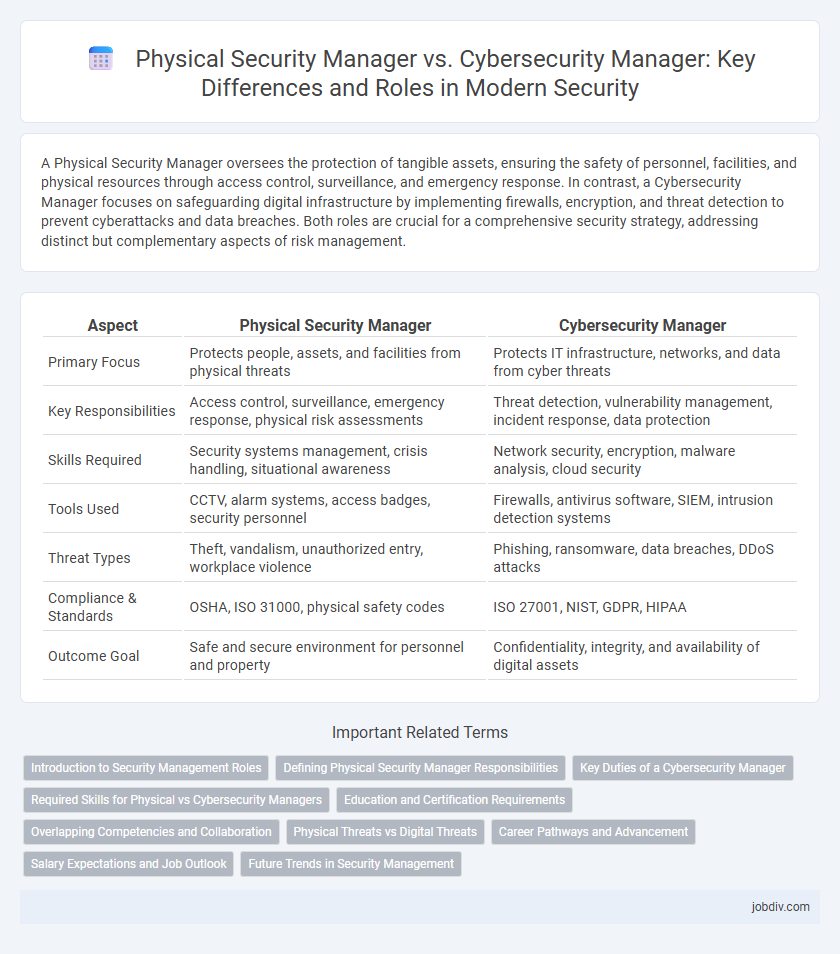A Physical Security Manager oversees the protection of tangible assets, ensuring the safety of personnel, facilities, and physical resources through access control, surveillance, and emergency response. In contrast, a Cybersecurity Manager focuses on safeguarding digital infrastructure by implementing firewalls, encryption, and threat detection to prevent cyberattacks and data breaches. Both roles are crucial for a comprehensive security strategy, addressing distinct but complementary aspects of risk management.
Table of Comparison
| Aspect | Physical Security Manager | Cybersecurity Manager |
|---|---|---|
| Primary Focus | Protects people, assets, and facilities from physical threats | Protects IT infrastructure, networks, and data from cyber threats |
| Key Responsibilities | Access control, surveillance, emergency response, physical risk assessments | Threat detection, vulnerability management, incident response, data protection |
| Skills Required | Security systems management, crisis handling, situational awareness | Network security, encryption, malware analysis, cloud security |
| Tools Used | CCTV, alarm systems, access badges, security personnel | Firewalls, antivirus software, SIEM, intrusion detection systems |
| Threat Types | Theft, vandalism, unauthorized entry, workplace violence | Phishing, ransomware, data breaches, DDoS attacks |
| Compliance & Standards | OSHA, ISO 31000, physical safety codes | ISO 27001, NIST, GDPR, HIPAA |
| Outcome Goal | Safe and secure environment for personnel and property | Confidentiality, integrity, and availability of digital assets |
Introduction to Security Management Roles
A Physical Security Manager oversees the protection of tangible assets, facilities, and personnel by implementing access controls, surveillance systems, and emergency response protocols. A Cybersecurity Manager focuses on safeguarding digital infrastructure, networks, and sensitive information through risk assessments, threat mitigation, and incident response strategies. Both roles require expertise in security frameworks, compliance standards, and coordination with cross-functional teams to ensure comprehensive organizational security.
Defining Physical Security Manager Responsibilities
Physical Security Managers are responsible for protecting an organization's physical assets through access control systems, surveillance technologies, and emergency response planning. They oversee security personnel, coordinate with law enforcement, and implement protocols to prevent unauthorized entry, theft, and vandalism. Their role integrates risk assessments and compliance with safety regulations to minimize physical threats to facilities and personnel.
Key Duties of a Cybersecurity Manager
A Cybersecurity Manager is responsible for developing and implementing comprehensive security strategies to protect digital assets, overseeing threat detection, incident response, and vulnerability management across networks and systems. They coordinate cybersecurity teams, ensure compliance with regulatory standards such as GDPR and HIPAA, and manage risk assessments to identify and mitigate potential cyber threats. Their role includes continuous monitoring of security infrastructure, managing security audits, and collaborating with IT departments to enforce security policies and safeguard sensitive information.
Required Skills for Physical vs Cybersecurity Managers
Physical Security Managers require expertise in risk assessment, access control systems, surveillance technologies, emergency response coordination, and facility management, emphasizing on-site threat mitigation and personnel safety. Cybersecurity Managers need advanced knowledge in network security protocols, incident response, vulnerability assessment, encryption methods, and regulatory compliance, focusing on protecting digital assets and preventing cyber attacks. Both roles demand strong leadership and communication skills but differ fundamentally in their technical proficiencies and operational environments.
Education and Certification Requirements
Physical Security Managers typically require a bachelor's degree in criminal justice, security management, or a related field, with certifications such as CPP (Certified Protection Professional) enhancing career prospects. Cybersecurity Managers often hold degrees in computer science, information technology, or cybersecurity, complemented by certifications like CISSP (Certified Information Systems Security Professional) and CISM (Certified Information Security Manager). Both roles benefit from continuous education to stay current with evolving security threats and technologies.
Overlapping Competencies and Collaboration
Physical Security Managers and Cybersecurity Managers share overlapping competencies in risk assessment, incident response, and access control management, ensuring comprehensive protection of both physical and digital assets. Collaboration between these roles enhances threat detection, enabling integrated strategies that address vulnerabilities across interconnected systems and facilities. This synergy is critical for organizations aiming to safeguard sensitive information and infrastructure in an increasingly hybrid security landscape.
Physical Threats vs Digital Threats
Physical Security Managers concentrate on mitigating risks such as unauthorized access, theft, vandalism, and natural disasters by implementing surveillance systems, access controls, and emergency response plans. Cybersecurity Managers address digital threats including malware, phishing attacks, hacking, and data breaches through firewalls, encryption, intrusion detection systems, and vulnerability assessments. Both roles are critical in protecting an organization's assets, with Physical Security focusing on tangible risks and Cybersecurity safeguarding digital information and networks.
Career Pathways and Advancement
Physical Security Managers typically advance through roles such as security supervisor, facility manager, and director of security, leveraging expertise in access control, surveillance, and emergency response. Cybersecurity Managers often progress from positions like information security analyst or network security engineer to chief information security officer (CISO), emphasizing skills in threat analysis, incident response, and compliance. Both career pathways demand continuous education and certifications, including CPP for physical security and CISSP or CISM for cybersecurity, to support upward mobility and leadership roles.
Salary Expectations and Job Outlook
Physical Security Managers typically earn an average salary ranging from $70,000 to $110,000 annually, driven by expertise in facility protection and risk assessment. Cybersecurity Managers command higher salaries, often between $100,000 and $150,000, reflecting demand for skills in network defense and data breach prevention. Job outlook for Cybersecurity Managers is projected for faster growth due to increasing cyber threats, whereas Physical Security Managers maintain steady demand linked to corporate and infrastructure security needs.
Future Trends in Security Management
Physical Security Managers will increasingly integrate advanced technologies such as AI-driven surveillance, IoT sensors, and biometrics to enhance threat detection and response capabilities. Cybersecurity Managers will focus on adaptive frameworks leveraging machine learning, zero-trust architectures, and quantum-resistant encryption to combat growing cyber threats in a hyper-connected landscape. The convergence of physical and cyber security disciplines will create hybrid roles emphasizing comprehensive risk management and real-time data analytics for proactive defense strategies.
Physical Security Manager vs Cybersecurity Manager Infographic

 jobdiv.com
jobdiv.com